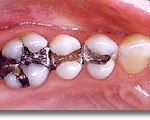 Dental restorations are placed to restore the function, anatomy and integrity of tooth structure which can be lost due to various reasons such as dental caries, trauma and etc. They can be broadly classified into two categories: direct and indirect restorations. Direct filling materials are used for chair side restorations where as indirect restorations such as crowns, bridges, inlays are fabricated outside the patient’s mouth. Before we venture into the pros and cons of different types of restorative materials, let me explain to you the requirements of an ideal dental filling material.
Dental restorations are placed to restore the function, anatomy and integrity of tooth structure which can be lost due to various reasons such as dental caries, trauma and etc. They can be broadly classified into two categories: direct and indirect restorations. Direct filling materials are used for chair side restorations where as indirect restorations such as crowns, bridges, inlays are fabricated outside the patient’s mouth. Before we venture into the pros and cons of different types of restorative materials, let me explain to you the requirements of an ideal dental filling material.
An ideal dental filling material should
-Â Â Â Â Â Â Â Â Â Last for a long time.
-Â Â Â Â Â Â Â Â Â Withstand the hostile environment of the oral cavity.
-Â Â Â Â Â Â Â Â Â Strong enough /should not deform under large stress.
-Â Â Â Â Â Â Â Â Â Do not cause any biological effects to human body.
Dental amalgam
Dental amalgam was first introduced in United States during 1833. It is then widely used as dental filling material over the years due its strength (it can withstand large stress), durability (especially for posterior teeth), and low cost (cheaper compared to dental gold and tooth colored restorations). Â Dental amalgam is often associated with mercury toxicity and this is the main reason why dental amalgam is discontinued in several countries. You can click here for more information on amalgam dangers. http://www.intelligentdental.com/2011/09/09/dangers-of-amalgam-dental-fillings/
Other disadvantages of dental amalgam:
-Â Â Â Â Â Â Â Â Â Â Unaesthetic appearance, dental amalgam does not resemble natural tooth color.
-Â Â Â Â Â Â Â Â Â Long setting time. It requires around 24 hours for dental amalgam to develop its maximum strength.
-Â Â Â Â Â Â Â Â Â Amalgam cannot bond to your enamel and dentine, thus it requires more destruction of your sound tooth structure to achieve sufficient strength and retention.
Gold foil filling
Gold foil is one of the oldest dental restorative materials. It was once used extensively in dentistry due to its durability (They can last approximately 10 to 15 years.) and ability to resist corrosion.However,gold foil fillings are more expensive compared to other restorative material and they require more time and skill during the placement of restoration.
Tooth colored dental fillings
Dental Composite(Most common alternative to dental amalgam)
Dental composite are mixtures of organic resin reinforced with inorganic filler (glass).
Advantages of dental composite:
-Â Â Â Â Â Â Â Â Â Esthetically pleasing. They resemble your natural tooth color and are very useful in restoring anterior teeth. They are also available in variety of shades to blend with your nature tooth color.
-Â Â Â Â Â Â Â Â Â Bond chemically to your enamel and dentine and provide extra strength to your remaining tooth structure.
Several disadvantages of dental composite:
-Â Â Â Â Â Â Â Â Â Technically sensitive. Good moisture control is required during placement of composite filling material and it takes longer time to place composite fillings.
-Â More expensive compared to other dental filling materials.
-Â Â Â Â Â Â Â Â Â Discolored easily. Dental composites can pick up stains over some time.
-Â Â Â Â Â Â Â Â Â Shorter life span compared to dental amalgam.
 Life span of dental composite: at least 5 years
Life span of dental amalgam: at least 7 years.
-Â Â Â Â Â Â Â Â Â Â Shrink during placement. This can reduce the quality of dental restoration. One way to overcome this problem is by placing dental composite in layers.
Glass ionomer cement
Main advantages of glass ionomer cement:
– Tooth colored dental filling material. Glass ionomer cements offer a satisfactory match with natural tooth.
– Glass ionomer cement is made of fluoroaluminosilicate glass which has fluoride releasing ability. This will strengthen and reduce the chance of dental caries developing around the restoration.
– Glass ionomer cement has the ability to adhere naturally to enamel and dentine.
–Less cavity preparation is needed.
Disadvantages of glass ionomer cements:
-Glass ionomer cements are brittle, and easier to fracture compared to other dental filling materials.
-Must be protected from moisture contamination especially the first hour. Patients are normally instructed not to chew using that particular tooth for the next 24 hours.
– Poor abrasion resistance and they are susceptible to acid attack.
– Glass ionomer cements restoration cannot be detected using dental Xrays